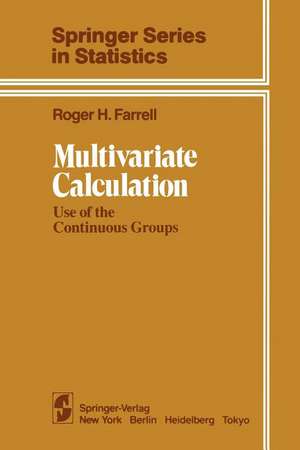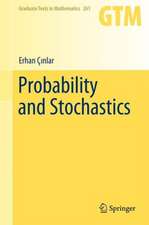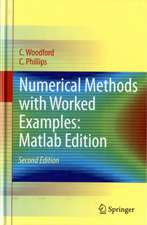Multivariate Calculation: Use of the Continuous Groups: Springer Series in Statistics
Autor R. H. Farrellen Limba Engleză Paperback – 21 oct 2011
Din seria Springer Series in Statistics
- 14%
 Preț: 679.60 lei
Preț: 679.60 lei - 20%
 Preț: 630.97 lei
Preț: 630.97 lei - 20%
 Preț: 816.43 lei
Preț: 816.43 lei - 20%
 Preț: 1000.84 lei
Preț: 1000.84 lei -
 Preț: 390.84 lei
Preț: 390.84 lei - 20%
 Preț: 697.13 lei
Preț: 697.13 lei - 20%
 Preț: 445.20 lei
Preț: 445.20 lei - 20%
 Preț: 881.51 lei
Preț: 881.51 lei - 18%
 Preț: 1237.14 lei
Preț: 1237.14 lei - 18%
 Preț: 967.22 lei
Preț: 967.22 lei - 18%
 Preț: 956.50 lei
Preț: 956.50 lei - 18%
 Preț: 794.25 lei
Preț: 794.25 lei - 15%
 Preț: 648.05 lei
Preț: 648.05 lei - 18%
 Preț: 1222.49 lei
Preț: 1222.49 lei - 15%
 Preț: 646.11 lei
Preț: 646.11 lei - 15%
 Preț: 647.08 lei
Preț: 647.08 lei - 15%
 Preț: 646.11 lei
Preț: 646.11 lei - 18%
 Preț: 1389.62 lei
Preț: 1389.62 lei - 15%
 Preț: 652.81 lei
Preț: 652.81 lei - 18%
 Preț: 1114.52 lei
Preț: 1114.52 lei - 18%
 Preț: 952.40 lei
Preț: 952.40 lei - 18%
 Preț: 1393.27 lei
Preț: 1393.27 lei - 18%
 Preț: 1561.68 lei
Preț: 1561.68 lei - 18%
 Preț: 1231.47 lei
Preț: 1231.47 lei - 15%
 Preț: 513.64 lei
Preț: 513.64 lei - 18%
 Preț: 893.71 lei
Preț: 893.71 lei - 15%
 Preț: 649.87 lei
Preț: 649.87 lei - 18%
 Preț: 1007.65 lei
Preț: 1007.65 lei - 18%
 Preț: 1111.67 lei
Preț: 1111.67 lei - 18%
 Preț: 1229.10 lei
Preț: 1229.10 lei - 18%
 Preț: 892.74 lei
Preț: 892.74 lei - 18%
 Preț: 913.26 lei
Preț: 913.26 lei - 18%
 Preț: 943.88 lei
Preț: 943.88 lei -
 Preț: 391.61 lei
Preț: 391.61 lei -
 Preț: 391.22 lei
Preț: 391.22 lei - 18%
 Preț: 1391.04 lei
Preț: 1391.04 lei -
 Preț: 390.84 lei
Preț: 390.84 lei - 18%
 Preț: 893.84 lei
Preț: 893.84 lei - 18%
 Preț: 960.61 lei
Preț: 960.61 lei - 18%
 Preț: 1245.34 lei
Preț: 1245.34 lei - 18%
 Preț: 964.54 lei
Preț: 964.54 lei - 15%
 Preț: 643.16 lei
Preț: 643.16 lei - 18%
 Preț: 1674.70 lei
Preț: 1674.70 lei - 15%
 Preț: 643.84 lei
Preț: 643.84 lei - 15%
 Preț: 586.37 lei
Preț: 586.37 lei - 18%
 Preț: 1004.99 lei
Preț: 1004.99 lei - 15%
 Preț: 643.34 lei
Preț: 643.34 lei - 18%
 Preț: 806.40 lei
Preț: 806.40 lei - 18%
 Preț: 727.66 lei
Preț: 727.66 lei
Preț: 393.90 lei
Nou
Puncte Express: 591
Preț estimativ în valută:
75.38€ • 79.06$ • 62.75£
75.38€ • 79.06$ • 62.75£
Carte tipărită la comandă
Livrare economică 01-15 aprilie
Preluare comenzi: 021 569.72.76
Specificații
ISBN-13: 9781461385301
ISBN-10: 146138530X
Pagini: 396
Ilustrații: 376 p.
Dimensiuni: 155 x 235 x 21 mm
Greutate: 0.55 kg
Ediția:Softcover reprint of the original 1st ed. 1985
Editura: Springer
Colecția Springer
Seria Springer Series in Statistics
Locul publicării:New York, NY, United States
ISBN-10: 146138530X
Pagini: 396
Ilustrații: 376 p.
Dimensiuni: 155 x 235 x 21 mm
Greutate: 0.55 kg
Ediția:Softcover reprint of the original 1st ed. 1985
Editura: Springer
Colecția Springer
Seria Springer Series in Statistics
Locul publicării:New York, NY, United States
Public țintă
ResearchCuprins
1 Introduction and Brief Survey.- 1.1. Aspects of Multivariate Analysis.- 1.2. On the Organization of the Book.- 1.3. Sources and the Literature.- 1.4. Notations.- 2 Transforms.- 2.0. Introduction.- 2.1. Definitions and Uniqueness.- 2.2. The Multivariate Normal Density Functions.- 2.3. Noncentral Chi-Square, F-, and t-Density Functions.- 2.4. Inversion of Transforms and Hermite Polynomials.- 2.5. Inversion of the Laplace and Mellin Transforms.- 2.6. Examples in the Literature.- 3 Locally Compact Groups and Haar Measure.- 3.0. Introduction.- 3.1. Basic Point Set Topology.- 3.2. Quotient Spaces.- 3.3. Haar Measure.- 3.4. Factorization of Measures.- 3.5. Modular Functions.- 3.6. Differential Forms of Invariant Measures on Matrix Groups.- 3.7. Cross-Sections.- 3.8. Solvability, Amenability.- 4 Wishart’s Paper.- 4.0. Introduction.- 4.1. Wishart’s Argument.- 4.2. The Noncentral Wishart Density Function.- 4.3. James on Series, Rank 3.- 4.4. Related Problems.- 5 The Fubini-Type Theorems of Karlin.- 5.0. Introduction.- 5.1. The Noncentral t-Density.- 5.2. The Wishart Density Function.- 5.3. The Eigenvalues of the Covariance Matrix.- 5.4. The Generalized T.- 5.5. Remarks on Noncentral Problems.- 5.6. The Conditional Covariance Matrix.- 5.7. The Invariant S22-1/2S21S11-1S12S22-1/2.- 5.8. Some Problems.- 6 Manifolds and Exterior Differential Forms.- 6.0. Introduction.- 6.1. Basic Structural Definitions and Assumptions.- 6.2. Multilinear Forms, Algebraic Theory.- 6.3. Differential Forms and the Operator d.- 6.4. Theory of Integration.- 6.5. Transformation of Manifolds.- 6.6. Lemmas on Multiplicative Functionals.- 6.7. Problems.- 7 Invariant Measures on Manifolds.- 7.0. Introduction.- 7.1. ?nh.- 7.2. Lower Triangular Matrices, Left and Right Multiplication.- 7.3. S(h).- 7.4.The Orthogonal Group O(n).- 7.5. Grassman Manifolds Gk,n-k.- 7.6. Stiefel Manifolds Vk,n.- 7.7. Total Mass on the Stiefel Manifold, k = 1.- 7.8. Mass on the Stiefel Manifold, General Case.- 7.9. Total Mass on the Grassman Manifold Gk,n-k.- 7.10. Problems.- 8 Matrices, Operators, Null Sets.- 8.0. Introduction.- 8.1. Matrix Decompositions.- 8.2. Canonical Correlations.- 8.3. Operators and Gaussian Processes.- 8.4. Sets of Zero Measure.- 8.5. Problems.- 9 Examples Using Differential Forms.- 9.0. Introduction.- 9.1. Density Function of the Critical Angles.- 9.2. Hotelling T2.- 9.3. Eigenvalues of the Sample Covariance Matrix XtX.- 9.4. Problems.- 10 Cross-Sections and Maximal Invariants.- 10.0. Introduction.- 10.1. Basic Theory.- 10.2. Examples.- 10.3. Examples: The Noncentral Multivariate Beta Density Function.- 10.4. Modifications of the Basic Theory.- 10.5. Problems.- 11 Random Variable Techniques.- 11.0. Introduction.- 11.1. Random Orthogonal Matrices.- 11.2. Decomposition of the Sample Covariance Matrix Using Random Variable Techniques. The Bartlett Decomposition.- 11.3. The Generalized Variance, Zero Means.- 11.4. Noneentral Wishart, Rank One Means.- 11.5. Hotelling T2 Statistic, Noneentral Case.- 11.6. Generalized Variance, Nonzero Means.- 11.7. Distribution of the Sample Correlation Coefficient.- 11.8. Multiple Correlation, Algebraic Manipulations.- 11.9. Distribution of the Multiple Correlation Coefficient.- 11.10. BLUE: Best Linear Unbiased Estimation, an Algebraic Theory.- 11.11. The Gauss—Markov Equations and Their Solution.- 11.12. Normal Theory. Idempotents and Chi-Squares.- 11.13. Problems.- 12 The Construction of Zonal Polynomials.- 12.0. Introduction.- 12.1. Kronecker Products and Homogeneous Polynomials.- 12.2. Symmetric Polynomials in n Variables.-12.3. The Symmetric Group Algebra.- 12.4. Young’s Symmetrizers.- 12.5. Realization of the Group Algebra as Linear Transformations.- 12.6. The Center of the Bi-Symmetric Matrices, as an Algebra.- 12.7. Homogeneous Polynomials II. Two-Sided Unitary Invariance.- 12.8. Diagonal Matrices.- 12.9. Polynomials of Diagonal Matrices X.- 12.10. Zonal Polynomials of Real Matrices.- 12.11. Alternative Definitions of Zonal Polynomials. Group Characters.- 12.12. Third Construction of Zonal Polynomials. The Converse Theorem.- 12.13. Zonal Polynomials as Eigenfunctions. Takemura’s Idea.- 12.14. The Integral Formula of Kates.- 13 Problems for Users of Zonal Polynomials.- 13.0. Introduction.- 13.1. Theory.- 13.2. Numerical Identities.- 13.3. Coefficients of Series.- 13.4. On Group Representations.- 13.5. First Construction of Zonal Polynomials.- 13.6. A Teaching Version.- 14 Multivariate Inequalities.- 14.0. Introduction.- 14.1. Lattice Ordering of the Positive Definite Matrices.- 14.2. Majorization.- 14.3. Eigenvalues and Singular Values.- 14.4. Results Related to Optimality Considerations.- 14.5. Loewner Ordering.- 14.6. Concave and Convex Measures.- 14.7. The FKG-Inequality.- 14.8. Problems.
















